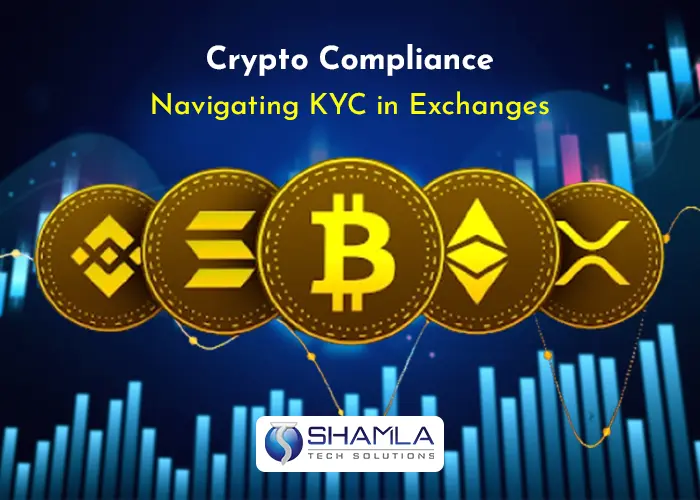What is a cryptocurrency exchange?
A cryptocurrency exchange is a platform where individuals and entities can buy, sell, or trade cryptocurrencies for other digital currencies or traditional currencies such as US dollars or Euros. These exchanges serve as intermediaries between buyers and sellers and make their profit through transaction fees and commissions.
There are two main types of cryptocurrency exchanges: fiat exchanges and cryptocurrency-to-cryptocurrency exchanges. Fiat exchanges allow the direct transfer of government-backed currencies for cryptocurrencies, facilitating the entry and exit points for crypto investors who need to convert their traditional money into digital form. Cryptocurrency-to-cryptocurrency exchanges offer a platform for trading one digital currency for another and tend to offer a wider variety of traded cryptocurrencies.
Cryptocurrency exchanges operate 24/7, providing a market where participants can trade based on current market prices, which fluctuate due to supply and demand dynamics. The price of a cryptocurrency on an exchange is determined in real-time through the actions of buyers and sellers in the market.
These platforms come with various features such as market orders, limit orders, stop-loss orders, margin trading, and sometimes derivatives trading, providing traders with tools to execute trades according to their strategies.
Users of exchanges must register and, in compliance with regulatory requirements, go through an identity verification process to prevent money laundering and fraud. This process is known as Know Your Customer (KYC). Upon successful verification, users can deposit funds through various methods, including bank transfers, credit cards, or other cryptocurrencies.
Security is a paramount concern, and exchanges use a combination of hot (online) and cold (offline) storage for the safeguarding of assets. Despite this, exchanges have been targets of hacking and theft, highlighting the importance of choosing reputable platforms and using additional personal security measures such as two-factor authentication.
How to Build a Cryptocurrency Exchange?
Research and Compliance: Understand legal regulations and obtain necessary licenses for the jurisdictions you plan to operate in.
Business Model: Choose the types of exchange (centralized, decentralized, hybrid) before you build cryptocurrency exchange and the features you’ll offer.
Architecture Design: Plan a robust, scalable architecture with secure databases, trading engines, and a wallet system. This planning is a must before you build cryptocurrency exchange.
Technology Development: Develop or procure secure trading engines, wallet systems, and KYC/AML systems.
User Interface: Design a user-friendly interface for web and mobile.
Security Measures: Implement measures like 2FA, encryption, and cold storage.
Liquidity: Partner with market makers or integrate with other exchanges for liquidity.
Testing and Launch: Conduct extensive testing, both internally and via public beta, before launching.
How does Cryptocurrency Exchange work?
Cryptocurrency exchanges function as digital marketplaces where traders can buy and sell cryptocurrencies using different currencies. The operation of these platforms is facilitated by crypto exchange software, which is the backbone of any cryptocurrency exchange platform, enabling the match-making of buy and sell orders, executing transactions, and providing interactive trading interfaces.
Create a cryptocurrency exchange maintained by specialized cryptocurrency exchange development companies, and this software must ensure high performance, security, and scalability to handle the volume of transactions and the diversity of users’ demands. The software is equipped with algorithms that determine the exchange rates based on market activity, and it securely manages users’ wallets and transactions.
A cryptocurrency exchange connects to the blockchain of the respective cryptocurrency it supports, using a series of cryptographic and financial procedures to enable the trading of digital assets. It often provides additional services such as market analytics, trading bots, and margin trading, all facilitated through the underlying exchange software.
Cryptocurrency exchanges vary in terms of the services they offer, security measures, regulatory compliance, and the number of supported cryptocurrencies and fiat currencies. As digital currencies continue to gain mainstream adoption, the role of cryptocurrency exchange platforms and the software that powers them remains critical in facilitating the wider use and acceptance of cryptocurrencies.
Are cryptocurrency exchanges safe?
Create Cryptocurrency exchange, the platforms where digital currencies are traded, vary in safety and security. The level of safety largely depends on the measures implemented by the exchange. Top exchanges prioritize robust security protocols such as two-factor authentication (2FA), end-to-end encryption, and cold storage of assets to minimize risks of hacking and theft. However, the industry has witnessed significant security breaches over the years, underscoring the inherent risks involved.
Moreover, regulatory compliance plays a crucial role in ensuring the safety of exchanges. Exchanges that adhere to regulatory standards are generally considered safer as they must follow stringent guidelines related to customer protection and anti-money laundering (AML) practices.
Despite these measures, users must remain vigilant. It’s advisable to use exchanges with a strong security track record and to implement personal security practices like using strong, unique passwords and enabling all available security features on their accounts. Ultimately, while exchanges are becoming safer, absolute safety cannot be guaranteed in the rapidly evolving cryptocurrency landscape.
Which cryptocurrency exchange should I use?

Choosing the right type of exchange before develop cryptocurrency exchange depends on your specific needs, including the types of cryptocurrencies you want to trade, your level of trading experience, and your security requirements. When selecting a cryptocurrency exchange, consider factors like security, user interface, customer support, and the types of trading options available.
Security: Opt for a cryptocurrency exchange that employs robust security measures. This includes the use of top-tier crypto exchange software, which ensures advanced security protocols such as two-factor authentication, SSL encryption, and cold storage of digital assets.
User Experience: The interface of the cryptocurrency exchange platform should be intuitive and user-friendly, suitable for both beginners and experienced traders. Some platforms also offer demo accounts to help newcomers get acclimated without financial risk.
Range of Services: Check if the exchange provides additional services like margin trading, futures, and options, which can enhance your trading experience.
Reputation and Compliance: Choose a cryptocurrency exchange developed by a reputable cryptocurrency exchange development company known for compliance with regulatory requirements. This helps ensure that the platform adheres to necessary legal and financial guidelines, providing an additional layer of security.
Fee Structure: Transparent fee structures without hidden costs are crucial. Compare the fee structures of different exchanges to find one that offers competitive rates.
How to Create a cryptocurrency exchange account?
Creating an account on a cryptocurrency exchange is a straightforward process, designed to be user-friendly due to the sophisticated crypto exchange software that powers these platforms. Here’s a step-by-step guide to setting up your account:
- Choose a Cryptocurrency Exchange: Start by selecting a cryptocurrency exchange. Research and compare different platforms to find one that suits your trading needs and security requirements. Consider factors such as user interface, security features, fee structure, and the cryptocurrencies offered.
- Visit the Website: Once you’ve chosen an exchange, visit its official website. Reputable cryptocurrency exchange platforms will have secure websites with HTTPS protocols.
- Sign Up: Look for a “Sign Up” or “Create Account” button, usually found on the home page. Clicking this will direct you to the registration page.
- Enter Your Details: You’ll be prompted to enter personal information such as your name, email address, and password. Some exchanges may also ask for a phone number for additional security verification.
- Verify Your Email: After submitting your registration form, the exchange will typically send a verification link to your email. Click this link to verify your email address.
- Complete KYC Process: Most exchanges require a Know Your Customer (KYC) verification to comply with regulatory requirements. This involves submitting identification documents such as a passport or driver’s license. The crypto exchange software securely processes these documents.
- Secure Your Account: Enhance your account’s security by enabling two-factor authentication (2FA). This provides an additional layer of security beyond just your password.
- Deposit Funds: Once your account is set up and verified, you can deposit funds into it. Cryptocurrency exchanges generally offer various deposit methods, including bank transfers, credit cards, and cryptocurrencies.
- Start Trading: With your account funded, you’re ready to start trading. Familiarize yourself with the platform’s trading interface, which is powered by advanced cryptocurrency exchange software, ensuring a smooth trading experience.
What are the fees associated with cryptocurrency exchanges?
The fees associated with develop cryptocurrency exchange and using can vary significantly depending on the platform chosen and the type of transactions performed. These fees are an essential consideration when selecting a cryptocurrency exchange, as they can affect the overall profitability of your trading activities.
- Trading Fees: Most cryptocurrency exchanges charge a fee for each trade or transaction conducted on their platform. This is typically a percentage of the trade amount and can vary depending on whether you are the maker (providing liquidity by placing a limit order) or the taker (taking liquidity by placing a market order). Some exchanges reduce trading fees as a user’s trading volume increases over a set period.
- Deposit and Withdrawal Fees: Cryptocurrency exchange platforms may also charge fees for depositing and withdrawing funds. Deposit fees can vary depending on the method of deposit, such as bank transfer, credit card, or cryptocurrency transfer. Withdrawal fees often depend on the type of cryptocurrency being withdrawn and the current state of the network required to process the transactions. The crypto exchange software automatically calculates these fees based on current network conditions.
- Conversion Fees: If you are exchanging between different cryptocurrencies, the exchange may charge a conversion fee. This fee is usually wrapped into the exchange rate provided by the cryptocurrency exchange development company that supplies the platform’s software.
- Network Fees: These are not fees charged by the exchange itself but are necessary for transactions on the blockchain network. Network fees vary based on the cryptocurrency and current network congestion.
- Service Fees: Some exchanges may charge additional service fees for offering special features like automated trading or enhanced security measures provided by the crypto exchange software.
Can I trade Fiat Currency for Cryptocurrencies on Exchanges?
Yes, you can trade fiat currency for cryptocurrencies on many cryptocurrency exchanges. This capability is a fundamental feature offered by numerous platforms, allowing for a direct and efficient entry point into the world of digital currencies.
Cryptocurrency exchanges that support fiat-to-crypto transactions use sophisticated crypto exchange software to facilitate these trades. This software is developed by specialized cryptocurrency exchange development companies that focus on integrating various payment gateways and ensuring compliance with financial regulations. This integration allows users to deposit fiat money directly from their bank accounts, credit cards, or other payment methods and use it to purchase cryptocurrencies.
When selecting a cryptocurrency exchange platform for fiat-to-crypto trading, it’s important to consider the types of fiat currencies accepted and the range of cryptocurrencies available. Some platforms might only support major currencies like the USD, EUR, or GBP, while others might offer a broader selection including smaller national currencies.
The process usually involves setting up an account on the exchange, completing necessary KYC (Know Your Customer) and AML (Anti-Money Laundering) procedures, and then depositing fiat money into your exchange account. Once the funds are deposited, you can use them to buy cryptocurrencies offered on the platform.
It’s essential to be aware of the fees associated with fiat transactions, which can include deposit fees, withdrawal fees, and trading fees. These fees vary by platform and can significantly affect your trading budget. Always ensure that the exchange you choose is reputable and offers robust security measures to protect your funds and personal information.
What is the difference between centralized and decentralized exchanges?

In the cryptocurrency world, exchanges are categorized into two main types: centralized and decentralized. Understanding the differences between these can significantly impact your approach to trading digital assets.
Centralized Cryptocurrency Exchange
A centralized cryptocurrency exchange (CEX) operates as a third-party intermediary that facilitates the trading of crypto assets. Much like traditional financial exchanges, these platforms are managed by an organization that maintains full control over all transactions. Users of centralized exchanges deposit their funds directly into the exchange’s wallets, and trades are conducted on the platform’s internal systems, not on the blockchain itself.
These platforms are popular because they provide fast transaction speeds, high liquidity, user-friendly interfaces, and access to a wide variety of trading pairs. Centralized exchanges use sophisticated crypto exchange software, developed by specialized cryptocurrency exchange development companies, to ensure smooth operation, security, and integration with traditional financial systems. However, the downside is that users must trust the exchange’s security measures and corporate integrity, as the exchange holds their funds. This setup has led to concerns over potential vulnerabilities to hacking and fraud.
Decentralized Cryptocurrency Exchange
A decentralized cryptocurrency exchange (DEX) operates without a central governing body. Instead, it uses cryptocurrency exchange software to facilitate direct peer-to-peer transactions that are executed directly on the blockchain through smart contracts. This design enhances security and privacy because it eliminates the need for users to transfer their assets to the exchange, reducing the risk of theft from hacking of the exchange.
Decentralized exchanges are praised for promoting the foundational blockchain principles of decentralization and anonymity. They typically provide stronger security because they do not hold users’ funds, assets, or personal data. However, they often suffer from lower liquidity, fewer trading features, and slower transaction speeds compared to centralized exchanges.
So, the choice between a centralized and decentralized cryptocurrency exchange platform should be based on your specific needs for security, liquidity, transaction speed, and ease of use. Each type has its advantages and limitations, and the best option depends on the user’s priorities in the context of trading and managing cryptocurrency.
How do I deposit funds into my exchange account?
Depositing funds into your cryptocurrency exchange account is a crucial step for participating in crypto trading. Here’s a comprehensive guide to help you navigate this process smoothly:
Step 1: Choose a Cryptocurrency Exchange
First, select a cryptocurrency exchange that suits your trading needs based on factors like supported currencies, fees, security features, and user reviews. Ensure the exchange is reputable and well-regulated to minimize risks.
Step 2: Create and Verify Your Account
Register an account by providing your email address, creating a password, and completing any necessary identity verification steps. This Know Your Customer (KYC) process, mandated by many exchanges, may require you to submit identification documents such as a passport or driver’s license. This step ensures compliance with anti-money laundering regulations and secures your account.
Step 3: Log in and Access the Deposit Section
Once your account is set up and verified, log in and navigate to the deposit section. This is typically found in the wallet or funds area of your account dashboard. Modern crypto exchange software, developed by leading cryptocurrency exchange development companies, ensures this process is user-friendly and secure.
Step 4: Select Your Deposit Type
Choose whether you want to deposit fiat money (like USD, EUR, or GBP) or cryptocurrency. If you’re depositing fiat, you may have several options such as bank transfer, credit/debit card, or e-wallets. For depositing cryptocurrencies, you’ll need to select the specific coin you wish to deposit.
Step 5: Follow the Specific Instructions
For Fiat Deposits: Follow the instructions for your chosen payment method. This may involve setting up a bank transfer or entering your card details. The cryptocurrency exchange platform may provide specific bank details or a payment gateway interface. Be aware of any deposit fees and processing times, which can vary depending on the method and the exchange.
For Crypto Deposits: The exchange will generate a wallet address for the specific cryptocurrency you are depositing. Copy this address, then go to the wallet where you currently hold your cryptocurrency, and use this address to send the funds. Always double-check the address, as transactions on the blockchain are irreversible.
Step 6: Confirm the Deposit
After initiating the deposit, it may take some time for the funds to appear in your account, depending on the payment method and network activity. For bank transfers, it could take several days, whereas cryptocurrency transfers might only take a few minutes or hours, depending on the network congestion.
Step 7: Check for Confirmation
Once the funds are deposited, you should receive a confirmation from the exchange either via email or in your exchange account. Confirm that the funds are available in your account balance for trading.
Security Tips:
Always ensure you are using a secure internet connection when making transactions.
Enable two-factor authentication (2FA) on your exchange account for added security.
Use hardware wallets or other secure means to store cryptocurrencies that are not actively being traded.
By following these steps, you can safely and efficiently deposit funds into your cryptocurrency exchange account, utilizing the advanced features of crypto exchange software to facilitate your trading activities.
How long do cryptocurrency transactions take on exchanges?
The duration of cryptocurrency transactions on exchanges can vary widely depending on several factors, including the type of cryptocurrency, the current network traffic, and the specific policies of the cryptocurrency exchange platform. Understanding these factors can help users set realistic expectations for transaction times.
- Type of Cryptocurrency:
Different cryptocurrencies operate on different blockchain technologies which have varying block times and transaction throughputs. For example, Bitcoin transactions typically take 10 minutes to an hour to be confirmed, depending on the network congestion. Ethereum transactions might be faster, generally taking anywhere from 15 seconds to a few minutes under normal conditions.
- Network Traffic:
Transaction times can be significantly affected by the amount of network traffic. During periods of high transaction volume, such as during price rallies or market crashes, more transactions are waiting to be processed in the mempool (the cryptocurrency transaction waiting area). This can lead to slower confirmation times unless a higher transaction fee is paid to prioritize the transaction within the network.
- Transaction Fees:
Users have the option to pay higher transaction fees to speed up the confirmation process. Miners or validators (in the case of Proof of Stake blockchains) prioritize transactions with higher fees since they are incentivized to earn more for their efforts in processing transactions. Crypto exchange software often provides users with the option to set custom fees or choose levels of fee priority.
- Exchange Processing Times:
Apart from the blockchain itself, the cryptocurrency exchange software and the operational protocols of the exchange also play a role in transaction times. After a transaction is confirmed on the blockchain, the exchange must also process and reconcile this within your account. Some exchanges may have additional security measures or batch processing techniques that can add to the processing time.
- Cryptocurrency Exchange Development Company:
The efficiency of the underlying exchange software, developed by the cryptocurrency exchange development company, also impacts transaction times. Well-designed software can quickly process transactions once they are confirmed by the blockchain, whereas poorly optimized software might lead to additional delays.
- Withdrawals and Deposits:
Deposits to an exchange typically require a certain number of confirmations on the blockchain before being credited to your account. Similarly, when withdrawing, once you have initiated a transaction on the exchange, it needs to be processed and broadcast to the blockchain network. The overall time until the funds are available in another wallet includes both the exchange processing time and the blockchain confirmation time.
Security and Regulatory Checks:
For security and compliance with regulatory requirements, exchanges might hold a transaction for manual review. This is often the case for large transactions or transactions flagged by the exchange’s monitoring systems.
While blockchain technology promises faster transaction capabilities compared to traditional banking systems, the actual time it takes for a cryptocurrency transaction on an exchange can be influenced by a mixture of network, exchange-specific, and external factors. Patience and understanding of these elements can help manage expectations and planning when trading cryptocurrencies
What is the KYC (Know Your Customer) process on cryptocurrency exchanges?

The KYC (Know Your Customer) process on cryptocurrency exchanges is a critical compliance measure that exchanges undertake to verify the identity of their users. This procedure is not only crucial for preventing financial crimes such as money laundering and terrorist financing but also helps in creating a more secure trading environment. Here’s an in-depth look at how the KYC process works on cryptocurrency exchanges:
- Importance of KYC in Cryptocurrency Transactions:
KYC processes are fundamental in the cryptocurrency space, governed by various regulatory frameworks across jurisdictions. These procedures help cryptocurrency exchanges ensure that they are not inadvertently facilitating illegal activities by verifying the identities of their users.
- Initial Account Creation:
When a user first signs up on a cryptocurrency exchange platform, basic information such as name, email address, and password is collected. However, to unlock full account functionalities, including higher transaction limits and withdrawal capabilities, completing the KYC process is often necessary.
- Submission of Personal Documents:
The KYC process generally requires users to submit personal identification documents. This may include a government-issued ID (like a passport or driver’s license), proof of residence (such as a utility bill or bank statement), and sometimes a recent photograph or selfie. The exact requirements can vary depending on the regulatory requirements the exchange needs to comply with.
- Verification Process:
Once documents are submitted, the cryptocurrency exchange uses its crypto exchange software to verify the authenticity of the documents. Modern cryptocurrency exchange platforms, equipped with advanced software developed by leading cryptocurrency exchange development companies, utilize automated systems that can quickly validate document authenticity and extract necessary data. Some platforms might also employ manual checks to ensure further accuracy.
- Enhanced Due Diligence (EDD):
For high-volume traders or transactions that involve large amounts of money, an enhanced due diligence process may be required. This involves collecting more detailed financial information and background checks to assess the risk associated with providing services to the user.
- Data Security:
Given the sensitive nature of the information collected during the KYC process, cryptocurrency exchanges must ensure robust data protection measures are in place. This includes employing encryption protocols to safeguard data and complying with privacy laws to protect user information.
- Ongoing Monitoring:
KYC is not a one-off process. Exchanges continue to monitor user activity to ensure that transactions remain consistent with the profile of the customer. Any suspicious activity is flagged for further review, and accounts may be re-verified if necessary.
- Regulatory Compliance:
Cryptocurrency exchange platforms must keep abreast of changes in regulatory standards regarding KYC and AML (Anti-Money Laundering) requirements. Failure to comply with these regulations can result in hefty fines and other legal consequences for the exchanges.
By conducting KYC checks, cryptocurrency exchanges not only comply with regulatory mandates but also build trust with their user base by ensuring a safe and transparent trading environment. While the process may sometimes delay the full activation of account capabilities, it is a critical step towards maintaining the integrity of the financial system in the digital age.
What should I do if I encounter an issue with a cryptocurrency exchange?
If you encounter an issue with a cryptocurrency exchange, the first step is to consult the support section of the exchange’s website. Most exchanges offer a comprehensive guide or FAQ section developed by the cryptocurrency exchange software to help resolve common issues. If this doesn’t help, contact their customer support team directly through email, live chat, or phone, if available.
Provide detailed information about your issue, including screenshots or transaction IDs as necessary. For persistent problems, consider reaching out through social media platforms, as some exchanges respond quickly to public inquiries to maintain their reputation. Always keep records of your communications with the exchange.

Shamla Tech: Leading Crypto Exchange Development With Expert Precision
As a leader in cryptocurrency exchange development, Shamla Tech delivers superior solutions for seamless and secure exchange platforms. Their team of expert blockchain developers excels in building robust and scalable exchanges on diverse blockchain networks like Ethereum and Binance Smart Chain.
With a focus on security, customization, and advanced trading features, Shamla Tech provides end-to-end solutions from architecture design to implementation. Their dedication ensures a streamlined launch for exchange platforms, offering tailored expertise for navigating the complexities of cryptocurrency exchange development.



